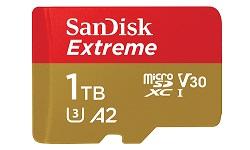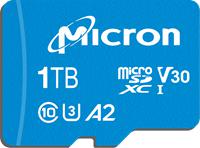Micro SD refreshes record in capacity, entering 1TB of era.
[Guide] Is it far from expanding the capacity of micro SD mobile card dedicated for monitoring to 1TB?
At the MWC2019 (Mobile World Congress), two storage solution providers SanDisk and Micron, announced the launch of 1TB micro SD, which means that the micro SD card has officially entered the era of 1TB.


By utilizing advanced 96-tier 3D quarter-layer-cell (QLC), Micron has released C200 series micro SDXC UHS-I card with capacity of 1TB. In addition to achieving significant expansion, Micron’s 1TB micro SD card has a reading speed of 100 MB/s and a writing speed of 95 MB/s. 1TB micro SD card of SanDisk has a continuous reading speed of 160 MB/s and a continuous writing speed of 90 MB/s. That is, both have advantages in writing speed and reading speed.
For consumers, the emergence of 1TB micro SD has raised the performance of mobile storage to a new level, especially in mobile phones and games. Users can shoot, share, store and enjoy more content freely. With short videos, high-definition videos and images becoming the current mainstream interactive information, the mobile storage scheme composed of super-large storage scheme and faster reading and writing speed will undoubtedly better meet the needs of users. However, the biggest problem may be the price. It is known that the price of the 1TB micro SD of SanDisk is about $450, undoubtedly unfriendly to consumers.
In 2018, Jeff Janukowicz, vice president of IDC Research, said, "Mobile devices have become the core of our lives. Today, users are accustomed to using smartphones for entertainment and business. We collect and share massive data on smartphones, UAVs, tablets, PCs, laptops and so on to provide better product services for users. As the functions of devices become more and more advanced, the need for higher quality content output will surely continue to increase, further enhancing the requirement of storage capacity. It is expected that in 2018, more than 150 billion applications will be installed by mobile device users worldwide, all of which require our storage devices to have larger storage capacity.
The continuous refresh of flash product capacity is inseparable from the continuous evolution of 3D NAND technology in recent years. Compared with 2D NAND, 3D NAND is a new type of flash memory. By stacking memory particles together, the limitations of 2D or planar NAND flash memory are broken through.
In recent years, 3D NAND has developed from 32-tier, 64-tier and 72-tier to 96-tier, continuously promoting flash memory products to bring new capacity records. According to the forecast of the municipal survey organization, it is expected that 3D NAND will stack 120 tiers or higher by 2020, and will be more than 140 tiers by 2021. At present, 96-tier 3D QLC NAND technology can achieve capacity of 1TB. It can be imagined that after 1TB, the capacity of micro SD mobile memory card will still have a huge space to rise in the next two years.
According to the latest information from SanDisk and Micron, the current 1TB micro SD card is more suitable for traditional consumer scenarios, such as mobile phones and other electronic devices.
Is it far from expanding the capacity of micro SD mobile card dedicated for monitation to 1TB?
From historical statistics of IHS Markit1, more than 98% of all micro SD cards sold worldwide in 2017 are used in consumer applications. In the non-consumer market, such as enterprise market, with the trend of edge computing and edge storage, the market of enterprise-class micro SD card will also boom. The most typical example is the field of autopilot and AI monitoring.
In 2018, SanDisk and Micron also launched micro SD cards for video surveillance edge storage, with capacity expanding from 32GB, 64GB to current 128GB and 256GB. Compared with the traditional consumer micro SD card, micro SD mobile card dedicated for video surveillance has higher requirements in the applicable environment (temperature), reading speed and writing speed. At the same time, for professional application scenarios such as security monitoring, memory card also emphasizes the durability of the product, that is, P/E cycle, and the self-monitoring (detection) function of storage system, in order to prevent data loss.
At present, with the guidance of the trend of edge computing in intelligent security, more and more emphasis is placed on the application of front-end intelligence, which will also put forward new requirements for the capacity and performance of front-end storage. Now although the emergence of mobile storage 1TB micro SD may not be applied to the field of video surveillance due to the cost and performance, there is no doubt that it provides a new imagination for mobile storage scheme in front-end surveillance.
